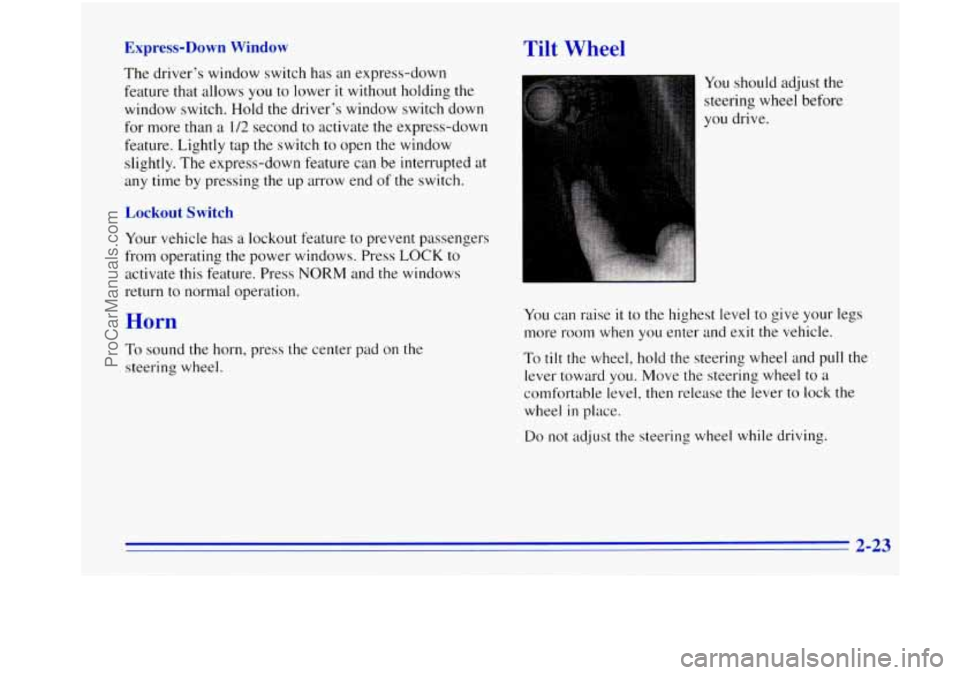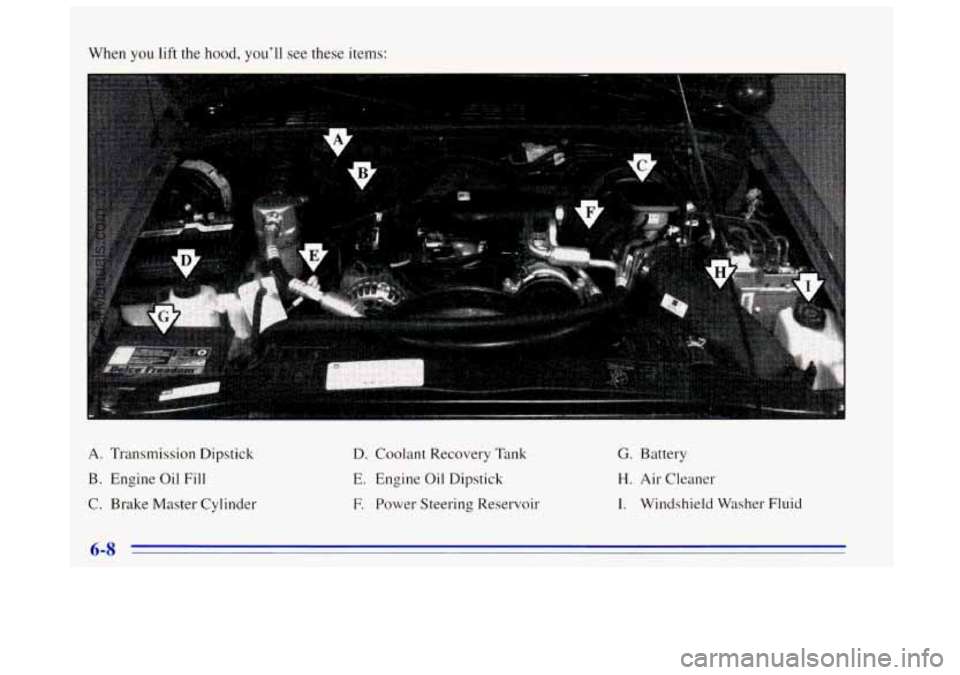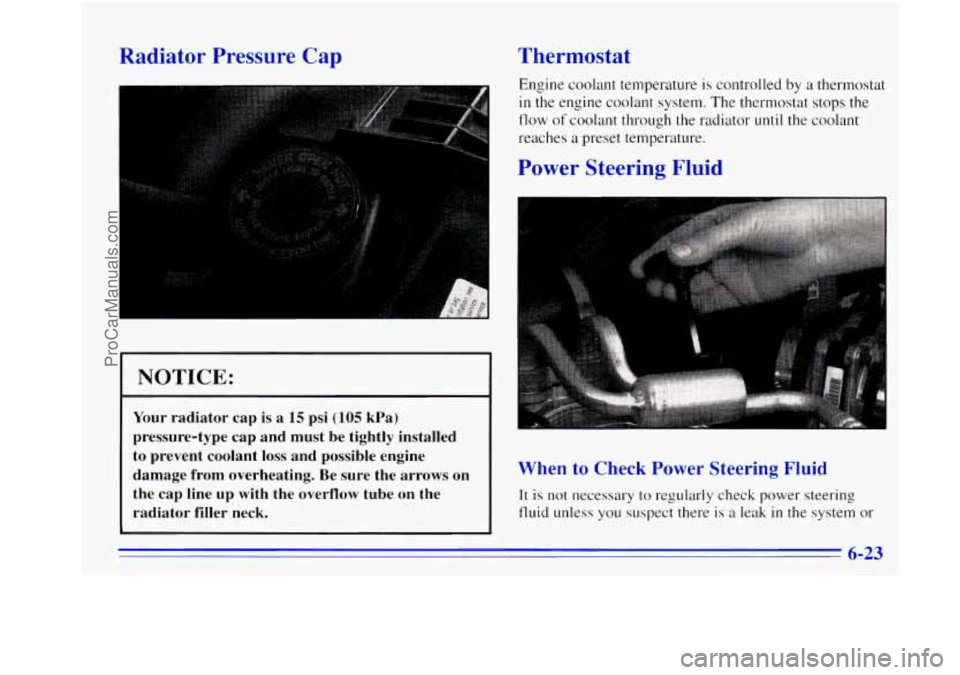power steering OLDSMOBILE BRAVADA 1996 Owners Manual
[x] Cancel search | Manufacturer: OLDSMOBILE, Model Year: 1996, Model line: BRAVADA, Model: OLDSMOBILE BRAVADA 1996Pages: 340, PDF Size: 17.49 MB
Page 60 of 340

Reach inside the endgate
to lift the handle and
open the endgate.
The endgate and glass will automatically lock
when shut.
To lock the power lock systern from the outside, insert
the key in the lock button and turn
it clockwise. All
doors will lock.
Remote Endgate Release
This button on the
driver’s side of the
steering column allows
you to release the endgate
from inside the vehicle.
Your shift lever must be in PARK
(P) or NEUTRAL (N)
for the release to work.
ProCarManuals.com
Page 75 of 340

Express-Down Window
The driver’s window switch has an express-uown
feature that allows you to lower it without holding the
window switch. Hold the driver’s window switch down
for more than
a 1/2 second to activate the express-down
feature. Lightly tap the switch to open
the window
slightly. The express-down feature can be interrupted at
any time by pressing the up arrow end of the switch.
Tilt Wheel
Lockout Switch
Your vehicle has a lockout feature to prevent passengers
from operating the power windows. Press
LOCK to
activate this feature. Press
NORM and the windows
return to normal operation.
Horn
To sound the horn, press the center ad on the
steerine wheel. You
should adjust the
steering wheel before
you drive.
You can raise it to the highest level to give your legs
more room when
you enter and exit the vehicle.
To
tilt the wheel, hold the steering wheel and pull the
lever toward
you. Move the steering wheel to a
comfortable level, then release the lever to lock the
wheel
in place.
Do not adjust the steering wheel while driving.
2-23
~
ProCarManuals.com
Page 136 of 340

Remember: Anti-lock doesn’t change the time you need
to get your foot up to the brake pedal or always decrease
stopping distance. If
you get too close to the vehicle in
front of you, you won’t have time to apply your brakes
if that vehicle suddenly slows or stops. Always leave
enough room up ahead to stop, even though you have
anti-lock brakes.
Using Anti-Lock
Don’t pump the brakes. Just hold the brake pedal
down and let anti-lock work for you. You may feel
the brakes vibrate, or you may notice some noise, but
this
is normal.
Braking in Emergencies
Use your anti-lock braking system when you need to.
With anti-lock, you can steer and brake at the same
time. In many emergencies, steering can help you more
than even the very best braking.
Steering
Power Steering
If you lose power steering assist because the engine
stops or the system is not functioning, you can steer but
it
will take much more effort.
Steering Tips
Driving on Curves
It’s important to take curves at a reasonable speed.
A lot of the “driver lost control” accidents mentioned on
the news happen on curves. Here’s why:
Experienced driver or beginner, each
of us is subject to
the same laws of physics when driving
on curves. The
traction
of the tires against the road surface makes it
possible for the vehicle to change its path when you turn
the front wheels. If there’s no traction, inertia will keep
the vehicle going in the same direction.
If you’ve ever
tried to steer a vehicle on wet ice, you’ll understand this.
The traction you can get in
a curve depends on the
condition
of your tires and the road surface, the angle at
which the curve is banked, and your speed. While you’re
in a curve, speed is the one factor you can control.
ProCarManuals.com
Page 147 of 340

Driving Uphill
Once you decide you can safely drive up the hill, you
need
to take some special steps.
0
0
0
Use a low gear and get a firm grip on the
steering wheel.
Get a smooth start up the hill and try to maintain
your speed. Don’t use more power than you need,
because you don’t want your wheels to start spinning
or sliding.
Try to drive straight up the hill if at all possible. If
the path twists and turns, you might want to find
;hn@h,w rQude.
Ease up on your speed as you approach the top
of the hill.
0 Attach a flag to the vehicle to make you more visible
to approaching traffic on trails or hills.
0 Sound the horn as you approach the top of the hill to
let opposing traffic know you’re there.
you more visible
to oncoming traffic.
0 Use your headlamps even during the day. They make
1 A CAUTION:
’hrning or driving across steep hills can be
dangerous. You could lose traction, slide
sideways, and possibly roll over. You could be
seriously injured or killed. When driving up hills,
always try to go straight up. Driving to the top (crest)
of
a hill at full speed can
cause an accident. There could be a drop-off,
embankment, cliff, or even another vehicle. You
could be seriously injured
or killed. As you near
‘---1 the top of a hill, slow down and stay alert.
ProCarManuals.com
Page 220 of 340

When you lift the hood, you’ll see these items:
A. Transmission Dipstick
B. Engine Oil
Fill
C. Brake Master Cylinder D.
Coolant Recovery Tank
E. Engine Oil Dipstick
E Power Steering Reservoir
G. Battery
H. Air Cleaner
I. Windshield Washer Fluid
6-8
ProCarManuals.com
Page 235 of 340

Radiator Pressure Cap
I
NOTICE:
Your radiator cap is a 15 psi (105 kPa)
pressure-type cap and must be tightly installed
to prevent coolant loss and possible engine
damage from overheating. Be sure the arrows on
the cap line up with the overflow tube on the
radiator filler neck.
Thermostat
Engine coolant temperature is controlled by a thermostat
in the engine coolant system. The thermostat stops the
flow of coolant through the radiator
until the coolant
reaches a preset temperature.
Power Steering Fluid
When to Check Power Steering Fluid
It is not necessary to regularly check power steering
fluid unless you suspect there is a leak in the system or
6-23
ProCarManuals.com
Page 236 of 340

you hear an unusual noise. A fluid loss in this system
could indicate a problem. Have the system inspected
and repaired.
How To Check Power Steering Fluid
When the engine compartment is cool, unscrew the cap
and wipe
the dipstick with a clean rag. Replace the cap
and completely tighten it. Then remove the cap again
and look at the fluid level on the dipstick.
The
level should be between the ADD and FULL marks.
If necessary, add only enough fluid to bring the level up
to the proper range.
What to Use
Refer to the Maintenance Schedule to determine what
kind of fluid to
use. See “Recommended Fluids and
Lubricants’’
in the Index. Always use the proper fluid.
Failure to use the proper fluid can cause leaks and
damage hoses and seals.
Windshield Washer Fluid
What to Use
When you need windshield washer fluid, be sure to read
the manufacturer’s instructions before
use. If you will be
operating your vehicle in an area where the temperature
may fall below freezing, use a fluid
that has sufficient
protection against freezing.
Adding Washer Fluid
Open the cap labeled WASHER FLUID ONLY. Add
washer fluid
until the tank is full.
6-24
ProCarManuals.com
Page 313 of 340

Part C: Periodic Maintenance
Inspections
Listed below are inspections and services which should
be performed at least twice
a year (for instance, each
spring and fall).
You should let your GM retailer’s
service department or other qualified service center do
these jobs. Make sure any necessary repairs are
completed at
once.
Proper procedures to perform these services may be
found in an Oldsmobile Service Manual. See “Service
and Owner Publications’’ in the Index.
Steering, Suspension and Front- Wheel-Drive
Ax . Boot and Seal Inspection
Inspect the front and rear suspension and steering
system for damaged,
loose or missing parts, signs of
wear or lack
of lubrication. Inspect the power steering
lines and hoses for proper hook-up, binding, leaks,
cracks, chafing, etc. Clean and then inspect the drive
axle boot seals for damage, tears or leakage. Replace
seals if necessary.
Exhaust System Inspection
Inspect the complete exhaust system. Inspect the body
near the exhaust system.
Look for broken, damaged,
missing or out-of-position parts as well as open seams,
holes, loose connections or other conditions which
could cause a
heat build-up in the floor pan or could let
exhaust fumes into the vehicle. See “Engine Exhaust”
in
the Index.
Radiator and Heater Hose Inspection
Inspect the hoses and have them replaced if they are
cracked, swollen or deteriorated. Inspect all pipes,
fittings and clamps; replace as needed.
Throttle Linkage Inspection
Inspect the throttle linkage for interference or binding,
and for damage or missing parts. Replace parts as
needed. Replace any cables that have high effort or
excessive wear.
Do not lubricate accelerator and cruise
control cables.
7-43
ProCarManuals.com
Page 315 of 340

Part D: Recommended Fluids and
Lubricants
NOTE: Fluids and lubricants identified below by name,
part number or specification may be obtained from your
GM retailer.
USAGE
Engine Oil
Engine Coolant
FLUID/LUBRICANT
Engine oil with the American
Petroleum Institute Certified For
Gasoline Engines “Starburst”
symbol
of the proper viscosity. To
determine the preferred viscosity
for your vehicle’s engine, see
“Engine
Oil” in the Index.
50/50 mixture of clean water
(preferably distilled) and GM
Goodwrench@ DEX-COOL” or
Havoline@ DEX-COOL
”
(orange-colored, silicate-free)
antifreeze conforming to GM
Specification 6277M. See “Engine
Coolant’’
in the Index.
USAGE
Coolant
Supplement
Sealer
Hydraulic Brake
System
Parking Brake
Cable Guides
Power Steering
System
Key Lock
Cylinders
FLUID/LUBRICANT
GM Part No. 3634621 or
equivalent
with a complete flush
and refill.
Delco Supreme
11 @ Brake Fluid
(GM Part
No. 1052535 or
equivalent
DOT-3 brake fluid).
Chassis lubricant
(GM Part
No. 1052497 or equivalent) or
lubricant meeting requirements of
NLGI Grade 2, Category
LB
or GC-LB.
GM Power Steering Fluid
(GM
Part No. 1052884 - 1 pt.,
1050017 - 1 qt., or equivalent).
DEXRON@-111 Automatic
Transmission Fluid.
Multi-Purpose Lubricant, Superlube@
(GM Part
No. 1234624 1
or equivalent).
7-45
ProCarManuals.com
Page 334 of 340

.
Anti-Lock Brake System Warning ............ 2-54. 4.6
Brake System Warning
.......................... 2-53
Charging System
............................... 2-51
Check Gages
........ : ..... ................. 2-59
Daytime Running Lamps Indicator
................ 2-59
Safety Belt Reminder
....................... 1.5. 2.50
Service Engine Soon
.......................... 2-55
Loading Your Vehicle
............................ 4-4
Locking Rear Axle
............................... 2-17
LockoutSwitch
................................ 2-23
Locks
.......................................... 2-3
Door
.......................................... 2-3
Key Lock Cylinder Service
..................... 7-40
Power Door
................................... 2-4
Rear Door Security
................................ 2-4
Steering Column Lock Check
.................... 7-42
Loss
of Control ....... ! ......................... 4-12
Lubricants and Fluids
.. i’ ...................... 6-58, 7-45
Lubrication Service, Body ........................ 7-40
Luggagecarrier
................................ 2-40
Lumbar Controls
................................. 1-2
Maintenance Record
........................... 7-47
Maintenance Schedule
............................. 7- 1
.Long Tripmighway
............................. 7-5
Owner Checks and Services
...................... 7-39
Periodic Maintenance Inspections
................ 7-43
..
1 I
Recommended-Fluids and Lubricants ............. 7-45
Scheduled Maintenance Services
.................. 7-3
Short TripKity
...... 1 ........................... 7-4
Maintenance, Underbody
.................... 6-50, 7-42
Maintenance When Trailer Towing
................. 4-51
Malfunction Indicator Lamp
...................... 2-55
Manual Passenger’s Seat
........ ’ . J ................ 1-1
Methanol
....................................... 6-3
Mirrors
........................................ 2-33
Outside
..................................... 2-34
Visor Vanity
.... ............... , ............ 2-42
Mode Button
................................... 2-35
Model Reference
................................. vi
Mountain Roads
................................ 4-35
Multifunction Lever
.......... ....... : .......... 2-24
Inside Daymight
Rearview
..................... 2-33
Net. Convenience
............................... 2-58
Neutral
....................................... 2-15
New Vehicle “Break-In”
......................... 2-10
Nightvision
................................... 4-28
Normal Maintenance Replacement
Parts ............. 6-57
odometer
............................... ’. .... 2-49
Off-Road Recovery
.............................. 4-10
Off-Road Driving
.............................. 4-14
Oil, Engine.
... , ................................... 6-9
9-6
ProCarManuals.com